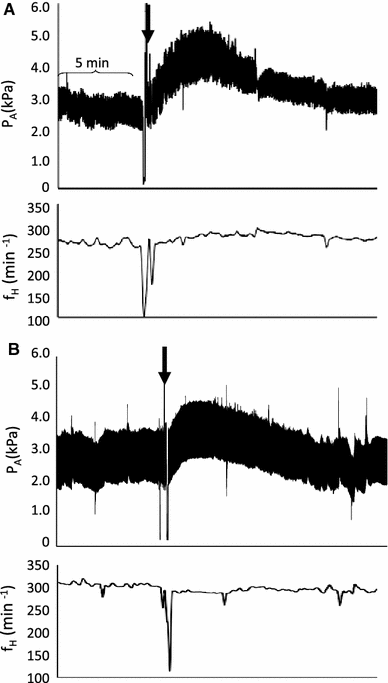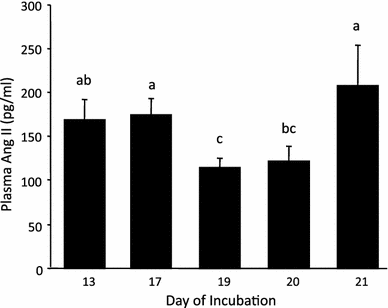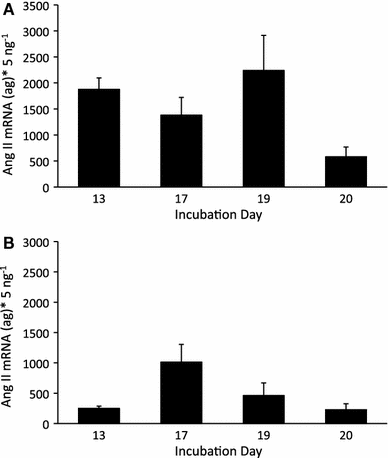Maturation of the angiotensin II cardiovascular response in the embryonic White Leghorn chicken (Gallus gallus)
- PMID: 20495810
- PMCID: PMC2940048
- DOI: 10.1007/s00360-010-0473-y
Maturation of the angiotensin II cardiovascular response in the embryonic White Leghorn chicken (Gallus gallus)
Abstract
Angiotensin II (Ang II) is an important regulator of cardiovascular function in adult vertebrates. Although its role in regulating the adult system has been extensively investigated, the cardiovascular response to Ang II in embryonic vertebrates is relatively unknown. We investigated the potential of Ang II as a regulator of cardiovascular function in embryonic chickens, which lack central nervous system control of cardiovascular function throughout the majority of incubation. The cardiovascular response to Ang II in embryonic chickens was investigated over the final 50% of their development. Ang II produced a dose-dependent increase in arterial pressure on each day of development studied, and the response increased in intensity as development progressed. The Ang II type-1 receptor nonspecific competitive peptide antagonist [Sar(1) ile(8)] Ang II blocked the cardiovascular response to subsequent injections of Ang II on day 21 only. The embryonic pressure response to Ang II (hypertension only) differed from that of adult chickens, in which initial hypotension is followed by hypertension. The constant level of gene expression for the Ang II receptor, in conjunction with an increasing pressure response to the peptide, suggests that two Ang II receptor subtypes are present during chicken development. Collectively, the data indicate that Ang II plays an important role in the cardiovascular development of chickens; however, its role in maintaining basal function requires further study.
Figures





Similar articles
-
The actions of the renin-angiotensin system on cardiovascular and osmoregulatory function in embryonic chickens (Gallus gallus domesticus).Comp Biochem Physiol A Mol Integr Physiol. 2014 Dec;178:37-45. doi: 10.1016/j.cbpa.2014.08.004. Epub 2014 Aug 20. Comp Biochem Physiol A Mol Integr Physiol. 2014. PMID: 25149042
-
ANG II and baroreflex control of heart rate in embryonic chickens (Gallus gallus domesticus).Am J Physiol Regul Integr Comp Physiol. 2013 Oct 15;305(8):R855-63. doi: 10.1152/ajpregu.00298.2013. Epub 2013 Sep 4. Am J Physiol Regul Integr Comp Physiol. 2013. PMID: 24005249
-
Effects of dehydration on cardiovascular development in the embryonic American alligator (Alligator mississipiensis).Comp Biochem Physiol A Mol Integr Physiol. 2012 Jul;162(3):252-8. doi: 10.1016/j.cbpa.2012.03.013. Epub 2012 Mar 29. Comp Biochem Physiol A Mol Integr Physiol. 2012. PMID: 22484708
-
Angiotensin II and the Cardiac Parasympathetic Nervous System in Hypertension.Int J Mol Sci. 2021 Nov 14;22(22):12305. doi: 10.3390/ijms222212305. Int J Mol Sci. 2021. PMID: 34830184 Free PMC article. Review.
-
Engagement of renin-angiotensin system in prostate cancer.Curr Cancer Drug Targets. 2011 May;11(4):442-50. doi: 10.2174/156800911795538101. Curr Cancer Drug Targets. 2011. PMID: 21395553 Review.
Cited by
-
Angiogenesis in the Avian Embryo Chorioallantoic Membrane: A Perspective on Research Trends and a Case Study on Toxicant Vascular Effects.J Cardiovasc Dev Dis. 2020 Dec 5;7(4):56. doi: 10.3390/jcdd7040056. J Cardiovasc Dev Dis. 2020. PMID: 33291457 Free PMC article. Review.
-
Thyroid hormone manipulation influences development of cardiovascular regulation in embryonic Pekin duck, Anas platyrhynchos domestica.J Comp Physiol B. 2018 Sep;188(5):843-853. doi: 10.1007/s00360-018-1166-1. Epub 2018 Jun 8. J Comp Physiol B. 2018. PMID: 29948159
-
Chronic captopril treatment reveals the role of ANG II in cardiovascular function of embryonic American alligators (Alligator mississippiensis).J Comp Physiol B. 2018 Jul;188(4):657-669. doi: 10.1007/s00360-018-1157-2. Epub 2018 Apr 6. J Comp Physiol B. 2018. PMID: 29623471
-
Critical developmental windows for morphology and hematology revealed by intermittent and continuous hypoxic incubation in embryos of quail (Coturnix coturnix).PLoS One. 2017 Sep 19;12(9):e0183649. doi: 10.1371/journal.pone.0183649. eCollection 2017. PLoS One. 2017. PMID: 28926567 Free PMC article.
-
A role for histamine in cardiovascular regulation in late stage embryos of the red-footed tortoise, Chelonoidis carbonaria Spix, 1824.J Comp Physiol B. 2013 Aug;183(6):811-20. doi: 10.1007/s00360-013-0746-3. Epub 2013 Feb 3. J Comp Physiol B. 2013. PMID: 23377695
References
-
- Aceto JF, Baker KM. [Sar] angiotensin II receptor-mediated stimulation of protein synthesis in chick heart cells. Am J Physiol Heart Circ. 1990;258:H806–H813. - PubMed
-
- Altimiras J, Crossley DA., II Control of blood pressure mediated by baroreflex changes of heart rate in the chicken embryo (Gallus gallus) Am J Physiol Regul. 2000;278:R980–R986. - PubMed
-
- Assali NS, Brinkman CR, Woods R, Dandavino A, Nuwayhid B. Ontogenesis of the autonomic control of cardiovascular functions in the sheep. In: Longo LD, Reneau DD, editors. Fetal and newborn cardiovascular physiology. New York: Garland STPM Press; 1978. pp. 47–92.
-
- Baker KM, Aceto JF. Angiotensin II stimulation of protein synthesis and cell growth in chick heart cells. Am J Physiol Heart Circ. 1990;259:H610–H618. - PubMed
-
- Bkaily G, El-Bizri N, Nader M, Hazzouri KM, Riopel J, Jacques D, Regoli D, D’Orleans-Juste P, Gobeil JF, Avedanian L. Angiotensin II induced increase in frequency of cytosolic and nuclear calcium waves of heart cells via activation of AT1 and AT2 receptors. Peptides. 2005;26(8):1418–1426. doi: 10.1016/j.peptides.2005.03.051. - DOI - PubMed
Publication types
MeSH terms
Substances
Grants and funding
LinkOut - more resources
Full Text Sources
Molecular Biology Databases
Miscellaneous

